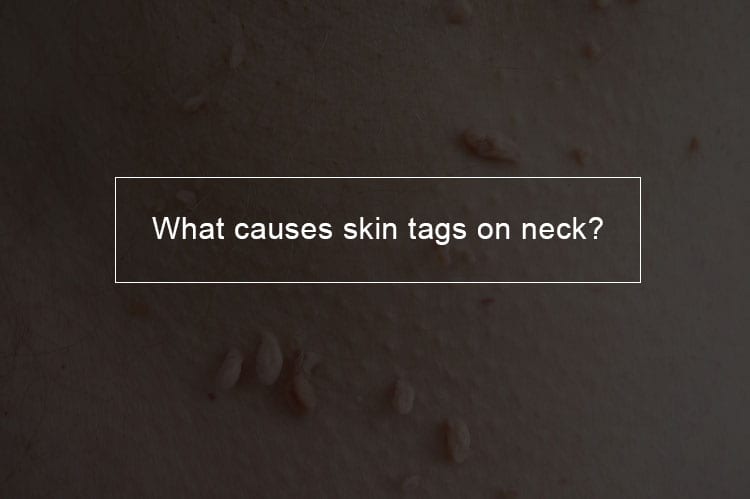
Your skin appearance can tell you what is going on with your internal system. For example, flushed cheeks may be a symptom of increased blood flow. Pimples or blemishes could indicate a reaction to various allergens. But what about skin tags? What are skin tags? What causes them, and most importantly is there a way to get rid of them? Read through to learn more about skin tags.
What are skin tags caused by?
What causes skin tags on neck?
Skin tags are usual, acquired benign skin growths that resemble a small, soft balloon suspended on a slender stalk. They are mild growths that can vary in several ways. Both males and females are equally vulnerable to developing skin tags. However, obesity seems to be linked with skin tag development. Even though some skin tags may fall off spontaneously, most persist once formed.
Whereas the exact cause of skin tags is unknown, researchers have speculated that pregnancy, family history, and friction process mat factor in. However, in many cases, skin tags are believed to develop as a result of friction between adjacent parts of the skin or between clothing and skin. The common areas for skin tags include:
- The neck
- Groin folds
- The underarms
- Upper chest especially beneath the breasts in women
- Eyelids
As a result of the increased skin to skin contact and friction, skin tags are more common in obese people. Even though skin tags can sometimes occur in children, they tend to increase with age and are most usual in middle-aged and older people.
Researches indicate an inherited susceptibility to the development of skin tags. The hormonal changes of pregnancy can also energize the growth of skin tags, especially during the second trimester of pregnancy.
What causes skin tags on babies?
If you have found a small soft piece of skin hanging on your baby’s body, do not panic, it is only a skin tag. Some babies are more prone to skin tags than others. If your baby lies in any of the below-mentioned categories, then he is likely to have skin tags:
- Obese and overweight babies develop skin tags.
- Genetic reasons are one of the main reasons for skin tags outgrowths.
- Kids who are diabetes patients are more likely to develop skin tags.
- If your baby is suffering from human papillomavirus, he is prone to skin tags
Are skin tags on babies harmful?
It is normal to panic when mothers see something wrong with their babies. However, skin tags are completely harmless. They are just extra outgrowths on the body and do not harm the baby in any way.
Sometimes, these skin swellings bleed, display multiple colors, or grow, and may even turn cancerous. Thus, if the skin tag on the baby’s body exhibits any such signs then take him to a pediatrician immediately, or go for cancer test.
Are skin tags contagious?
Skin tags are not contagious. There is no clinical proof that such skin outgrowth spreads from one person to another. Therefore, they are considered non-communicable.
Are skin tags a sign of cancer?
Cancerous skin tags
Skin tags are a type of harmless benign tumor. Skin tags are typically not cancerous and do not become cancerous if not treated. However, there are sporadic cases where a skin tag may become cancerous. As discussed above skin tag like bumps that bleed, grow, or display many colors such as pink, brown, red, or black can need a biopsy to exclude other causes, inclusive of skin cancer.
Which disease mimic a skin tag?
While skin tags are very characteristic in appearance and occur in specific locations such as the neck, under breasts, eyelids, underarms and groin folds, these tags may occur in less obvious locations. Other skin problems that may look similar to skin tag but not tag include moles, nerve and fiber-type moles and warts.
What are the signs of skin tags?
Apart from the appearance, skin tags do not cause physical pain or discomfort. These tiny skin patches generally cause signs when they are repeatedly irritated. Physical appearance is the leading cause of skin tag removal. Below are symptoms and signs which may necessitate skin tag removal:
- If the skin tag has become irritated and red from bleeding, or black from twisting
- Death of skin tissue
Sometimes, skin tags may become snagged by clothing, jewelry, pets, or seat belts causing pain or discomfort. Generally, these are very benign growths that have no cancer potential. Often, a tag may spontaneously fall off without any pain or discomfort. This may occur after the tag twisted on itself at the stalk base, interrupting the blood flow to the tag.
How does apple cider vinegar remove skin tags?
Skin tag removal with apple cider vinegar
If you are wondering how to get rid of tags yourself, you are not alone. Many people try to remove them at home. Which sometimes may be a bad idea. Burning or cutting any part of your skin intentionally may lead to infection or permanent scarring. Instead, consult a physician to get the proper care.
Skin tags are harmless. However, if it bothers you and you want to try home remedies you can use apple cider vinegar. The method is quite popular since it removes the tag without causing any pain. The acid in the vinegar damages the tissue that forms the blemish; even though the surrounding skin is not destroyed during this treatment.
Steps to follow when using apple cider vinegar to remove skin tag:
Step 1: Clean the skin around the blemish with warm water and mild soap.
Step 2: Dry the skin thoroughly.
Step 3: Scratch the skin tag gently with a toothpick. Do not let it bleed.
Step 4: Soak a small piece of cotton in apple cider vinegar and squeeze out the excess vinegar.
Step 5: Place the soaked cotton wool on the skin tag and hold it with a bandage.
Step 6: Leave it overnight
Step 7: Remove the bandage and cotton wool the next morning and wash thoroughly with water.
Step 8: Repeat for three to four days, until the skin tag darkens, dries and falls off.
Do creams remove skin tags on the face?
There are presently no medical approved creams for skin tags removal. Skin tags are removed by physical methods like cutting off or trying off with dental thread. It is not advisable to use unauthorized products such as hair removal creams to remove the skin tag. Trial uses of unapproved creams may lead to irritation and possible secondary complications. If you prefer the skin tag to be removed let it be done in a hospital. Below are the removal options:
- Severing; With the aid of surgical scissors or a scalpel, your doctor will cut the skin tag off. This approach may require stitches to heal.
- Freezing; A liquid nitrogen is sprayed or swabbed on to your skin tag. The element efficiently freezes the tissue, with less discomfort. With this treatment, the skin usually heals on its own.
- Burning; If your doctor prefers to superheat the tissue to remove the skin tag, he or she will possibly use electricity conducted through a wire. The heat burns the stem of the growth and facilitates a cleaner healing procedure.
There are surgical treatments available for skin tags. If you want to seek medical intervention, consult a doctor and get the skin tag removed by a laser technique or by cutting off the skin portion with a scalpel. If your baby’s tags are large, then your doctor will give him some general anesthesia as well.
However, if you are alright with your baby’s skin tags, there is no reason to treat them now. Skin tags are more of an embarrassment than a condition, and you can consider getting your baby skin tags removed when he is older. It has a lot to do with peer pressure and self-image. However, if you treat your baby regularly with the unusual growth on his body, then don’t take him to a surgeon just yet, surgery isn’t an advisable thing for a baby.
How can I avoid skin tags?
How to prevent skin tags?
It is not possible to avoid every type of skin tag. However, you can reduce your odds of getting them by staying at a healthy weight. Here are some prevention tips:
- Exercise frequently at least five days weekly for thirty minutes.
- Keep all skin folds dry to stop friction. Dry your skin well after bath or shower. Smear baby powder to skin folds like your underarms that tend to trap moisture.
- Consult your doctor or a dietitian to plan meals that are low in fat saturation and calories.
- Avoid wearing clothing or jewelry that irritates your skin.
- To minimize the amount of rubbing, create a barrier by wearing clean and breathable clothing that cushions areas that rub, such as in the groin and the armpits.
- Minimize the risk of skin tag if you have diabetes by eating a healthy diet and getting regular exercise, among other things.




